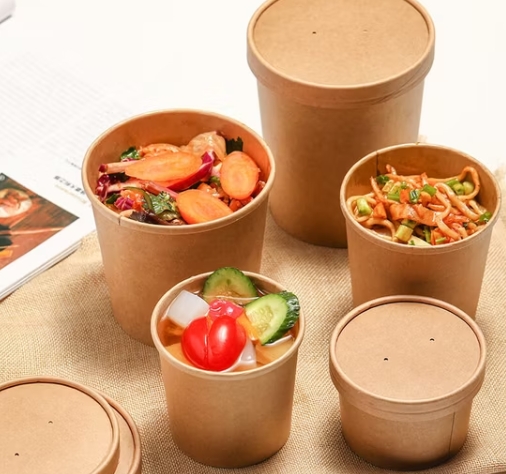
Content Menu
● Understanding Disposable Curry Bowls
● Eco-Friendliness of Disposable Curry Bowls
>> 1. Traditional Plastic Disposable Bowls
>> 2. Sugarcane Bagasse Disposable Curry Bowls
>> 3. Paper Disposable Curry Bowls
>> 4. Cornstarch-Based Bioplastic Bowls (PLA/CPLA)
● Safety of Disposable Curry Bowls for Hot Foods
>> 1. Heat Resistance and Food Safety
>> 2. Chemical Safety Concerns
>> 3. Reusability and Durability
● Practical Considerations for Using Disposable Curry Bowls
>> 1. Leak-Proof and Durability
>> 2. Microwave and Freezer Use
>> 3. Disposal and Composting
● Summary Table: Disposable Curry Bowls Comparison
● Conclusion
● FAQ
>> 1. Are disposable curry bowls made from sugarcane safe for hot food?
>> 2. Can disposable curry bowls be composted at home?
>> 3. Are plastic disposable curry bowls safe for reheating food?
>> 4. How do disposable curry bowls compare environmentally?
>> 5. Can disposable curry bowls with lids prevent leaks?
● Citations:
Disposable curry bowls have become increasingly popular in the foodservice industry, especially for takeout and delivery of hot, saucy dishes like curries. However, with growing environmental concerns and health awareness, many consumers and businesses are asking: Are disposable curry bowls eco-friendly and safe for hot foods? This comprehensive article explores the materials used, their environmental impact, safety considerations for hot food use, and practical tips for choosing the right disposable curry bowl.

Understanding Disposable Curry Bowls
Disposable curry bowls are single-use containers designed to hold curry dishes and other hot or cold foods. They are typically made from various materials, including:
- Plastic (polypropylene, PET)
- Sugarcane bagasse (a fibrous byproduct of sugarcane juice extraction)
- Paper with or without biodegradable coatings
- Cornstarch-based bioplastics (PLA/CPLA)
Each material has distinct properties affecting its eco-friendliness and safety for hot foods.
Eco-Friendliness of Disposable Curry Bowls
1. Traditional Plastic Disposable Bowls
Traditional plastic disposable bowls, often made from polypropylene (PP) or polyethylene terephthalate (PET), are widely used due to their durability and heat resistance. However, these plastics are petroleum-based and non-biodegradable, taking hundreds of years to break down in landfills and contributing to environmental pollution and greenhouse gas emissions[1][6].
While some plastic bowls are recyclable, contamination with food waste often leads to disposal in landfills. Thus, traditional plastic disposable curry bowls are generally not considered eco-friendly.
2. Sugarcane Bagasse Disposable Curry Bowls
Sugarcane bagasse bowls are made from the fibrous residue left after extracting sugarcane juice. This material is renewable, biodegradable, and compostable under industrial composting conditions[1][4][5][10].
- Environmental Benefits: Using agricultural waste reduces the need for virgin raw materials, lowers carbon footprint, and prevents deforestation[4][10].
- Biodegradability: Bagasse bowls decompose within 60 to 90 days in commercial composting facilities, returning nutrients to the soil without harmful residues[5][10].
- Certifications: Many manufacturers ensure their sugarcane bowls meet FDA food safety standards and certifications like European EN 13432 for compostability[5].
Bagasse bowls are widely regarded as an eco-friendly alternative to plastic disposable bowls for serving hot curries and other foods.
3. Paper Disposable Curry Bowls
Disposable paper bowls, often lined with plant-based bioplastics like PLA or coated with biodegradable materials, offer another sustainable option[1][3][11].
- Compostability: Paper bowls with certified compostable linings break down in industrial composting environments.
- Renewable Source: Made from fast-growing trees or agricultural residues.
- Limitations: Some paper bowls use plastic linings that can hinder compostability if not properly certified[3].
4. Cornstarch-Based Bioplastic Bowls (PLA/CPLA)
PLA (polylactic acid) and its crystallized form CPLA are bioplastics derived from fermented plant sugars, typically corn starch. These bowls offer plastic-like performance but are compostable under industrial conditions[4].
- Heat Resistance: CPLA bowls can withstand hot foods up to around 100°C (212°F) without warping.
- Environmental Impact: Renewable sourcing reduces fossil fuel dependence, but industrial composting is required for proper degradation.
- Limitations: Not suitable for prolonged microwave use or home composting.
Safety of Disposable Curry Bowls for Hot Foods
1. Heat Resistance and Food Safety
Disposable curry bowls must withstand high temperatures without deforming or leaching harmful chemicals into food. The safety depends largely on the material:
- Plastic Bowls: High-quality polypropylene (PP) and PET bowls are generally safe for hot food up to 120-140°C but may leach chemicals if reused excessively or damaged[2][6].
- Sugarcane Bagasse Bowls: Certified food-safe, microwave-safe, and can handle hot foods up to about 220°F (104°C). They do not contain harmful chemicals like BPA or PFAS[5][10].
- Paper Bowls: Designed for hot and cold foods, but heat resistance varies based on lining; some are microwave-safe[11].
- PLA/CPLA Bowls: Safe for hot food but should not be microwaved repeatedly[4].
2. Chemical Safety Concerns
- Some plastics can release chemicals like BPA, phthalates, or other additives when exposed to heat, posing health risks[2].
- Sugarcane bagasse bowls are free from such harmful chemicals and comply with FDA and European food safety standards[5].
- Choosing bowls certified for food contact safety (FDA, ISO, SGS) ensures minimal risk[11].
3. Reusability and Durability
While disposable curry bowls are designed for single use, some bagasse bowls can be wiped and reused a few times if not heavily soiled[10]. However, repeated use of plastic bowls can increase chemical leaching risks.

Practical Considerations for Using Disposable Curry Bowls
1. Leak-Proof and Durability
Disposable curry bowls must be sturdy enough to hold liquid-rich curries without leaking. Bagasse and PLA/CPLA bowls often feature seamless construction and tight-fitting lids to prevent spills[4][8].
2. Microwave and Freezer Use
- Bagasse bowls are microwave-safe and freezer-safe, adding versatility for consumers[5][10].
- Paper bowls with PLA lining may be microwave-safe but should be checked per product specifications[11].
- Plastic bowls vary; some are microwave-safe, but repeated heating can degrade them[2].
3. Disposal and Composting
- Compostable bowls (bagasse, PLA-lined paper) should be disposed of in industrial composting facilities for proper breakdown[1][3][4].
- Plastic disposable bowls should be recycled if facilities exist; otherwise, they end up in landfills[6][7].
- Proper disposal significantly affects the environmental impact of disposable curry bowls.
Summary Table: Disposable Curry Bowls Comparison
| Material | Eco-Friendliness | Heat Resistance | Food Safety | Compostability | Typical Use Cases |
| Plastic (PP, PET) | Low; non-biodegradable, recyclable | Up to 120-140°C | Risk of chemical leaching if reused | No | Hot and cold foods; durable |
| Sugarcane Bagasse | High; renewable, biodegradable | Up to ~104°C (220°F) | FDA & EU certified, chemical-free | Yes; industrial composting | Hot curries, soups, oily foods |
| Paper (PLA-lined) | Moderate; renewable, compostable | Varies; some microwave-safe | Certified food-safe | Yes; industrial composting | Hot and cold foods, salads, soups |
| PLA/CPLA Bioplastic | Moderate; renewable, compostable | Up to ~100°C | Food-safe, no BPA | Yes; industrial composting | Hot soups, curries, single-use only |
Conclusion
Disposable curry bowls can be both eco-friendly and safe for hot foods, but this depends heavily on the material used. Traditional plastic bowls, while durable and heat-resistant, pose significant environmental challenges and potential health risks if reused improperly. In contrast, sugarcane bagasse bowls stand out as a sustainable, biodegradable, and safe option for serving hot curries and other dishes. Paper bowls with compostable linings and cornstarch-based bioplastics offer additional eco-friendly alternatives, though they require proper industrial composting to realize their environmental benefits.
For consumers and businesses aiming to reduce environmental impact without compromising food safety and convenience, choosing certified compostable disposable curry bowls made from sugarcane bagasse or PLA-lined paper is the best path forward. Proper disposal and awareness of product specifications ensure these bowls serve as a responsible choice for hot food packaging.

FAQ
1. Are disposable curry bowls made from sugarcane safe for hot food?
Yes, sugarcane bagasse disposable curry bowls are safe for hot foods. They comply with FDA and European food safety standards and can withstand temperatures up to about 220°F (104°C) without releasing harmful chemicals[5][10].
2. Can disposable curry bowls be composted at home?
Most disposable curry bowls made from bagasse or PLA require industrial composting facilities to break down effectively. Home composting may not provide sufficient heat or microbial activity for complete degradation[4][5].
3. Are plastic disposable curry bowls safe for reheating food?
Plastic bowls made from polypropylene (PP) or PET can be safe for reheating if they are microwave-safe and in good condition. However, repeated heating and wear can increase chemical leaching risks, so they should be used cautiously[2].
4. How do disposable curry bowls compare environmentally?
Sugarcane bagasse bowls are much more eco-friendly than traditional plastic bowls because they use renewable agricultural waste, biodegrade quickly, and reduce landfill waste. Plastic bowls are petroleum-based and persist in the environment for centuries[1][4][5].
5. Can disposable curry bowls with lids prevent leaks?
Yes, many disposable curry bowls, especially those made from bagasse or PLA, come with tight-fitting lids that create secure seals to prevent leaks during transport[4][8][9].
Citations:
[1] https://www.biopak.com/hk-ch/containers-lids/bowls
[2] https://customcupfactory.com/blogs/news/is-it-safe-to-put-hot-food-in-a-plastic-container
[3] https://greenpaperproducts.com/collections/compostable-bowls
[4] https://www.bioleaderpack.com/top-8-best-disposable-bowls-for-hot-soup-durable-leak-proof-eco-friendly-choices/
[5] https://diyecobox.com/are-sugarcane-bowls-safe-for-food-use/
[6] https://www.alibaba.com/showroom/heat-resistant-disposable-bowl.html
[7] https://www.packagingenvironmental.co.uk/disposable-bowls
[8] https://takeawaypackaging.co.uk/online-shop/hot-food-containers/biodegradable-eco-bowl-and-lids/
[9] https://www.agreenproducts.ca/safe-and-secure-packing-tips-for-using-disposable-bowls-with-lids/
[10] https://foogogreen.com/sugarcane-faqs/
[11] https://biogreensg.com/product/disposable-paper-bowls/
[12] https://www.alibaba.com/showroom/disposable-curry-bowl.html
[13] https://chuk.in/products/disposable-bowls/
[14] https://www.bioleaderpack.com/top-8-best-disposable-bowls-for-hot-soup-durable-leak-proof-eco-friendly-choices/
[15] https://www.innaturepack.com/the-best-disposable-soup-bowls-with-lids-for-hot-soup/
[16] https://askpackagingltd.com/bagasse-bowls/
[17] https://www.reddit.com/r/cookingforbeginners/comments/13mz8e9/is_it_safe_to_put_hot_food_in_tupperware_and_then/
[18] https://www.natureearthpackaging.com/blog-post?blog_id=6
[19] https://trustprints.com/can-paper-bowls-hold-hot-soup/
[20] https://www.x-ide.com/?e=1334673393628
[21] https://www.biopak.com/hk/containers-lids/bowls
[22] https://www.epd.gov.hk/epd/sites/default/files/epd/english/environmentinhk/waste/pub_consult/files/tableware-con-doc-en.pdf

















